SEO copywriting is one of the most important ingredients in a successful SEO program.
You must be able to write great SEO content to engage with your audience and be visible on search engines to attract traffic.
In this post, you’ll learn:
- What SEO copywriting is
- Why it matters so much in your online marketing
- How to get started with SEO copywriting in 3 simple steps
- Expert tips to create the best SEO content
We will also share a list of SEO copywriting tools to help you get started.
Table of Contents
What is SEO Copywriting?
SEO copywriting is the digital marketing practice of writing online content in a way that is easy to understand for both readers and search engines.
It involves two main crafts:
- SEO
- Copywriting
Effective SEO copywriting involves optimizing the copy so that the web page ranks high in Google and other search engines.
The copy must be valuable to the reader. It also should be organized in such a way that search engines see how that content relates to specific search queries.
There are various elements of SEO copywriting, including:
- Topic and keyword research
- Aligning with search intent
- SERP (Search Engine Results Page) analysis
- Keyword optimization, including both a primary keyword and related keywords
- Creating optimized and clickable headlines
- Writing compelling meta descriptions
- Optimizing headings
- Optimizing for featured snippets
- Answering questions
- Keeping sections and paragraphs short
- Internal linking
- And more
Steps to Get Started with SEO Copywriting
You might be wondering: “How to do SEO copywriting?“
In 2018, I decided to launch my first website and to write SEO content. I was in the same situation as you. I had no clue about SEO and copywriting.
The preliminary steps were to learn and read a lot about SEO and copywriting best practices.
Then follow these simple steps
Step 1 – Understand your Core Topics and Audience
You’re running a business.
Perhaps you’re Head of Content in a SaaS company, you own an agency, or you’re a freelancer specializing in a particular niche.
Your objective revolves around promoting your services and products.
Start by listing your services or core products. Essentially, outline what you offer and highlight your value proposition.
Then, understand how your customers discover you on Google (the keywords they use) and pinpoint their pain points.
Grab a notebook or create a straightforward Excel sheet. Begin mapping the connection between your services and your target audience.

This exercise is straightforward but really important. You will create content that drives traffic and conversions and aligns with your audience’s problems.
Step 2 – Define the Keyword Journey
Now that you understand your main services and how people search for them, our next step is to map out their customer journey in their online searches.
When searching online, individuals typically progress through several steps before deciding on a product or service.
This process is often referred to as the ‘Keyword Journey.’
Potential customers usually begin with more informational or less commercial keywords before gradually moving towards more specific and commercial ones.
A typical marketing funnel consists of three stages: Informational, Consideration, and Decision.
Select one of your services and identify the potential keyword journey of your audience.
For example, let’s consider the category of ‘website development services.’ Here’s what the journey could look like:
- Informational Stage:
- How to create a website as a beginner
- Steps to build a website from scratch
- Website development tips for beginners
- What is website development?
- Consideration Stage:
- Website design ideas and inspiration
- Best website builders for small businesses
- Choosing the right platform for website development
- Importance of responsive web design
- Decision Stage:
- Affordable website development services
- Professional website design agency
- Custom website development solutions
- Website development packages and pricing
If you lack inspiration, feel free to use the following ChatGPT prompt.
🤖 ChatGPT Prompt for Keyword Journey
Define the keyword journey, illustrating how individuals search online as they progress from the information stage to the consideration and design stages. Focus on the main category, ‘ENTER YOUR CATEGORY KEYWORD’. Please provide four potential searches for each stage.
Step 3 – Do Keyword Research
In this step, your goal is to identify additional keywords.
I recommend that you focus on one of your main topics discovered previously and list related keywords.
Identify all of the relevant keywords and topics and seek to cover them in your content piece.
There are a number of keyword research tools you can use to help with this process, including:
- Ahrefs
- Semrush
- Keywords Everywhere
- Google Search Console (Displays the keywords for which your content is already visible in Google.)
Caution: As a beginner, avoid spending excessive time searching for keywords.
Instead, prioritize listing 10 to 20 pertinent keywords for a specific search query (e.g., “Steps to build a website from scratch”) to gain insight into how people conduct their searches.
Step 4 – Analyze the SERP
In order to write SEO content that ranks well in Google searches, understand what users are actually searching for.
One of the best ways to do this is to analyze the search engine results page (SERP) for your target keyword.
Through a SERP analysis, you gain a better understanding of what users are actually looking for.
thruuu makes it fast and easy to get a snapshot of top search results for a given query in just a single click.
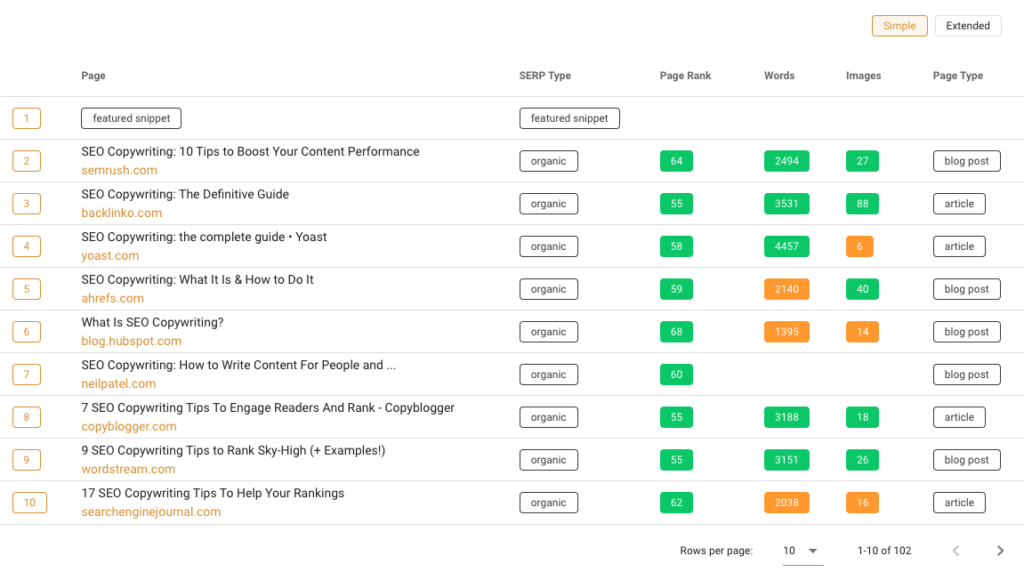
Using thruuu SERP Analysis Tool , you can quickly view and assess the following elements on Google page one:
- Title tags
- Meta descriptions
- H1s
- Other headings
- Content outlines
- Average word count
- SERP features
- Commonly used words and phrases
- People Also Ask (PAA) questions
- Related searches (at the bottom of the Google SERP)
- Videos in the SERP
- Videos in the content
- Images in the SERP
- Images in the content
- Common citations
As you can see below, you get an overview of all the articles ranking on Google and can easily spot the topic they cover and find inspiration.
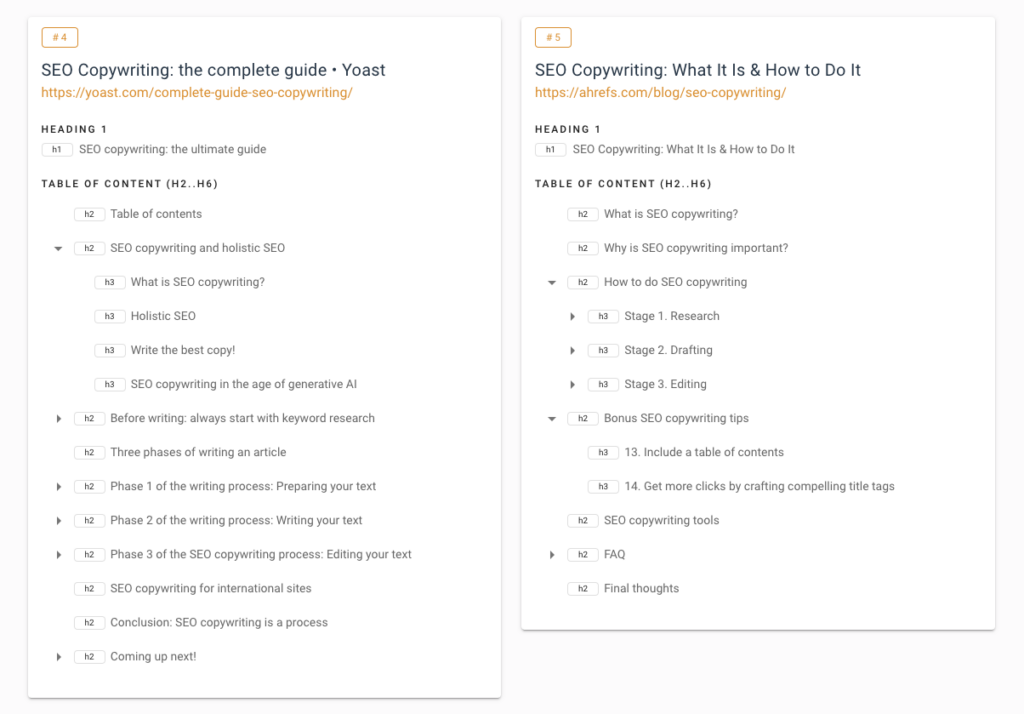
Start Analyzing Google for Free
Our end-to-end content optimization solution empowers your team to crack the Google algorithm, craft exceptional content, and achieve remarkable organic search results.
Step 5 – Create a Content Brief
After analyzing the SERP for your target keyword and gaining a better understanding of the topics you wish to cover, it’s recommended to create a content brief as a best practice
Important: Build a content brief for each content piece you produce.
A content brief serves as a strategic roadmap for SEO copywriting.
It helps to ensure that your content is on-topic, keyword-rich, organized, through, and aligned with the overall goals of your website.
A helpful content brief should include:
- Title of the content piece
- The overall message you want to communicate
- The primary keyword(s) you want to target
- A list of related keywords
- The search intent behind the query
- The target audience segment and persona for the piece
- An outline of the key points you want to cover
- Explanation of how the piece will be better and deliver more value than other options on Google page one
- A call-to-action (CTA) or multiple CTAs
- Helpful reference materials
By creating a content brief before you start writing, your copywriter can be focused and produce content that is more likely to satisfy all stakeholders.
thruuu makes it easy to create content briefs in a matter of minutes with an awesome Content Brief Generator feature.
Start by entering the primary keyword:
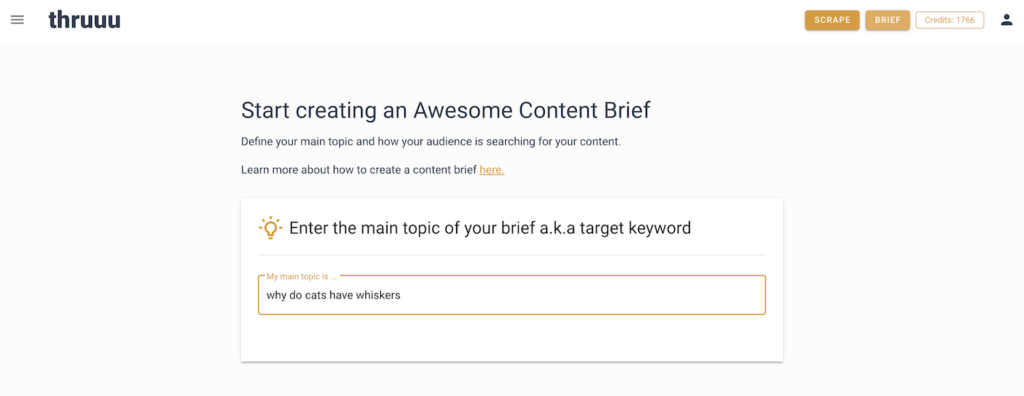
thruuu then scrapes the top Google search results for that keyword and returns SEO insights based on those results.
It automatically places those results into a content brief draft, saving you significant amounts of time and effort.
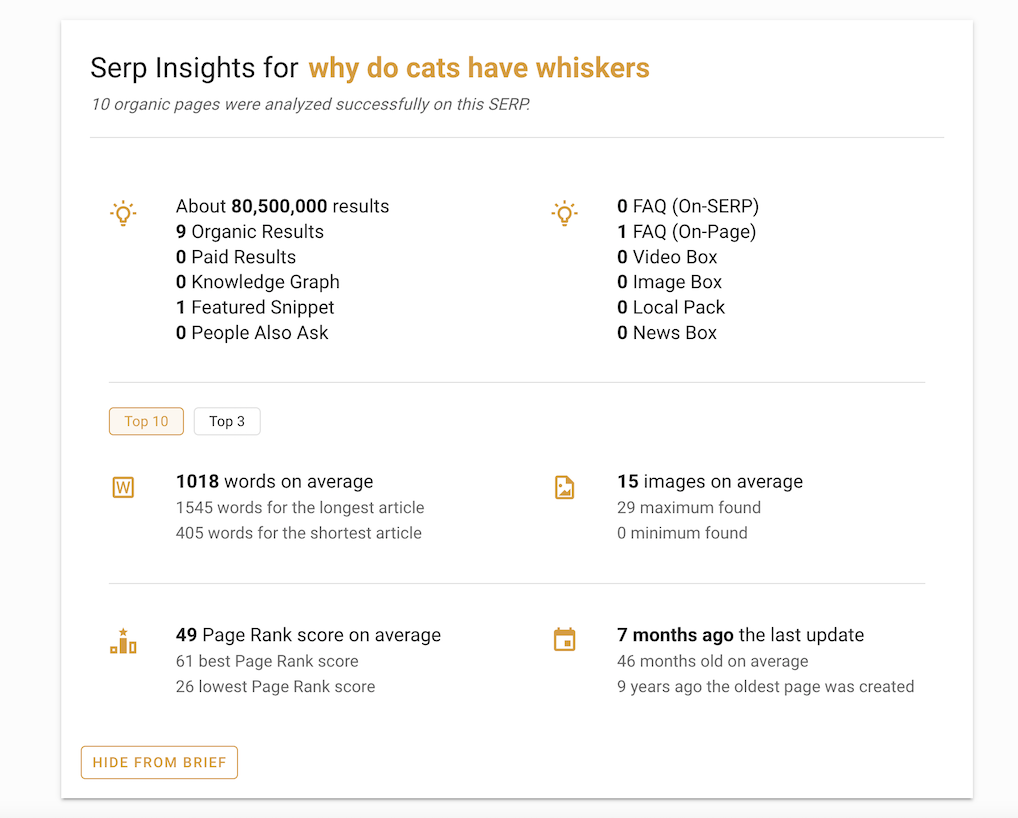
In addition to analyzing the top search results, thruuu allows you to give specific directions to the content writer:
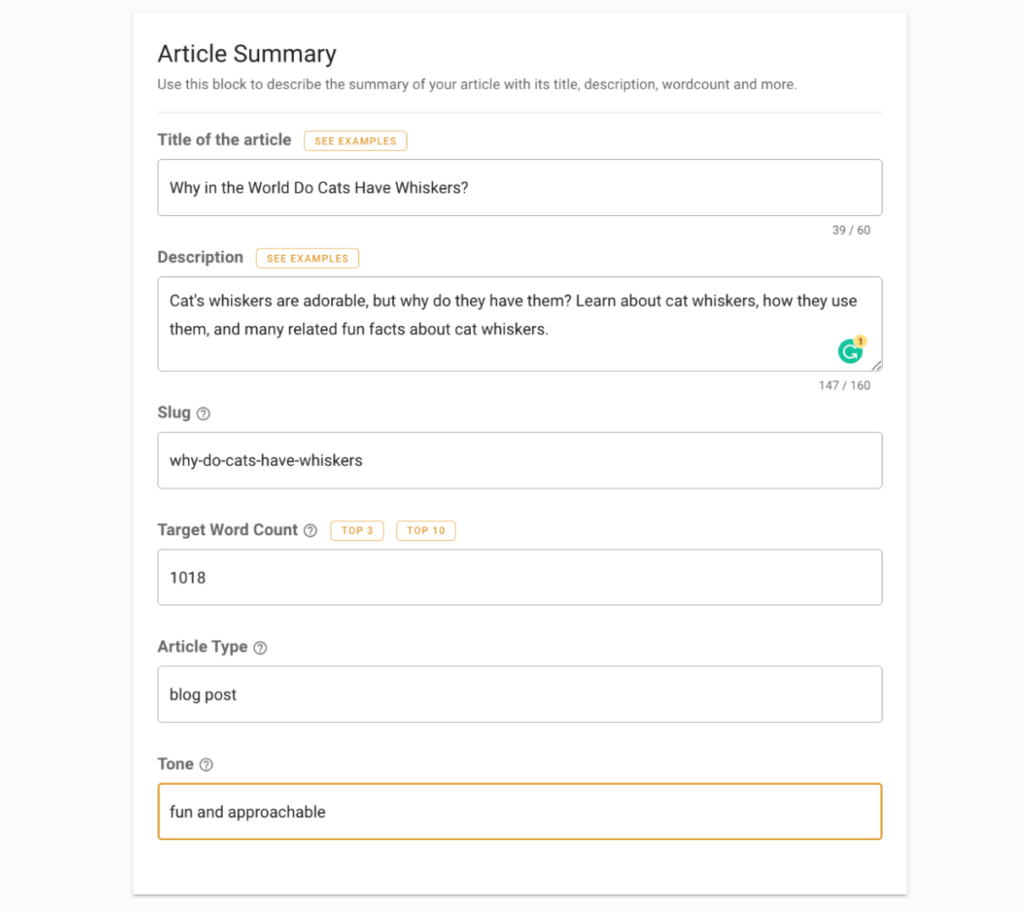
Based on the headings of the top-ranking content in the Google SERP, thruuu suggests an outline that you can customize however you wish.
You’re also free to compare and contrast against competitor outlines to help you identify important topics and any content gaps on which you can capitalize.
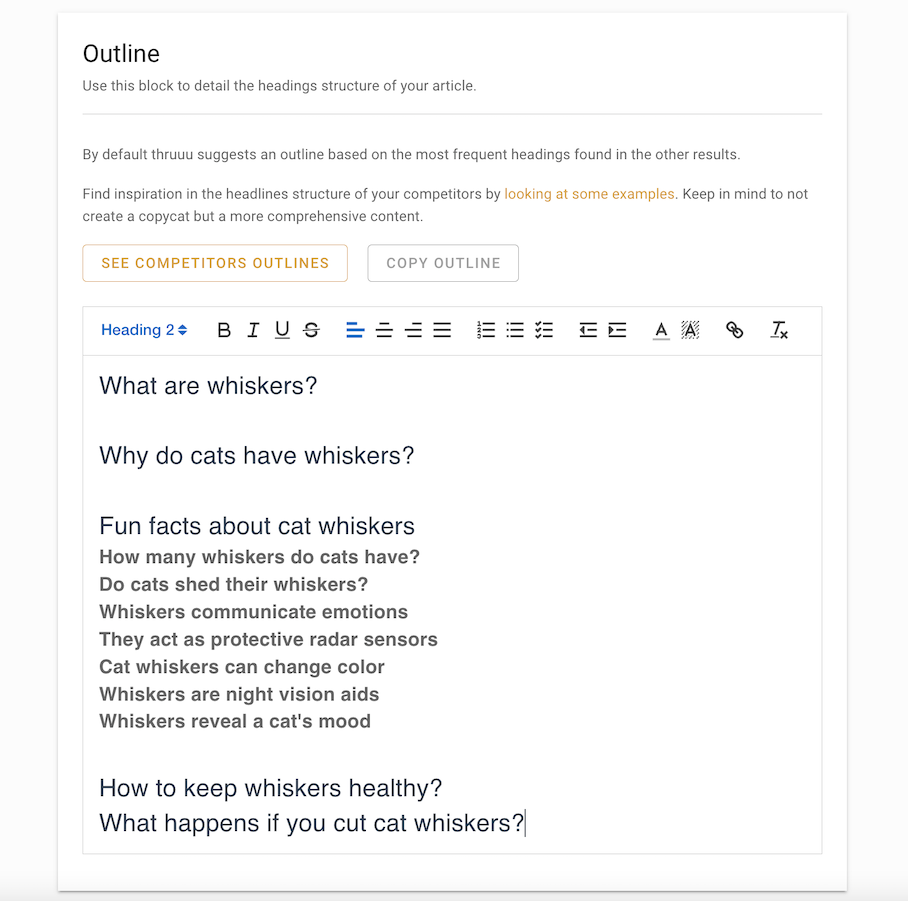
thruuu also reveals the top questions asked by searchers and suggests questions for you to answer in your content.
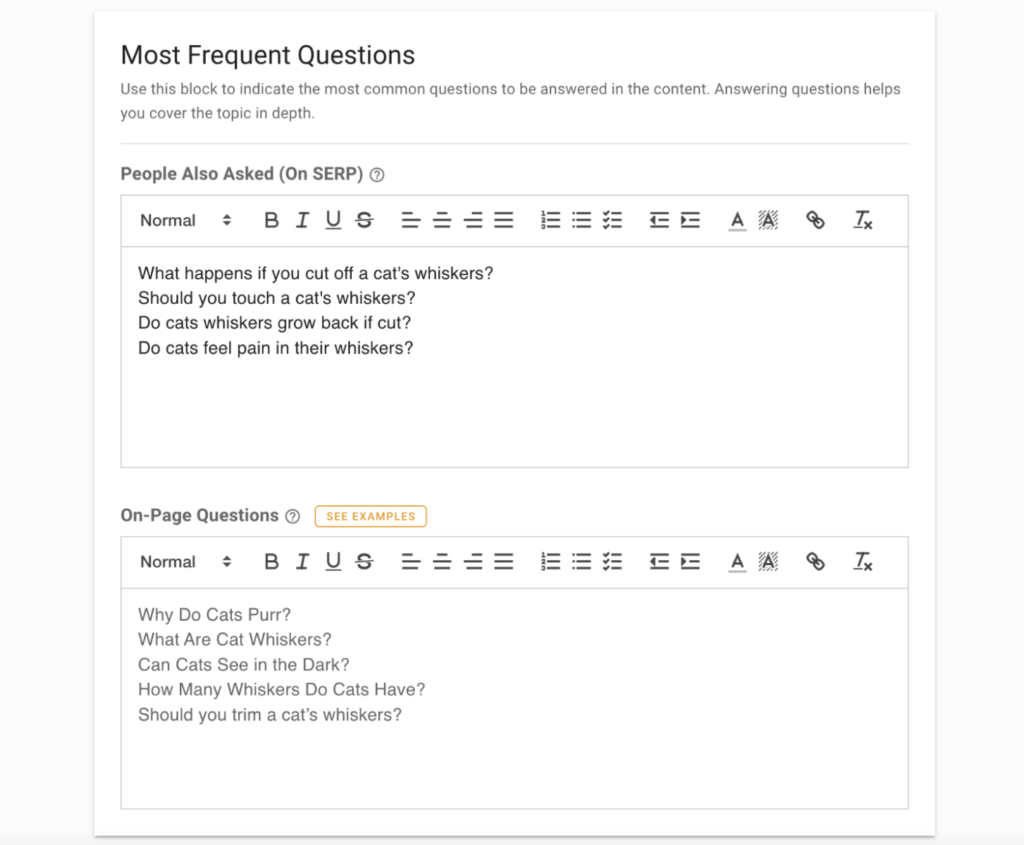
You can watch me here creating a comprehensive content brief.
The end result is a thorough content brief, including a list of headings to cover and some notes.
Either you can write the copy yourself or you can give it to a writer.
After completing these steps, including analyzing the SERP and aligning your copy with the keywords and topics your audience searches for, you’ll ensure the production of high-quality content with robust SEO optimization.
To go deeper into these steps, explore our tips and best practices for creating exceptional SEO content.
SEO Copywriting Tips
With your content brief in hand, you’re ready to produce new content.
When conducting your SEO copywriting, follow the below tips for greater organic search results and higher content ROI.
Tip 1 – Understand Search Intent
Search intent is the reason someone is typing a particular query into the search engine.
There are four main types of searches:
- Informational – The user is looking for information about a topic. For example, “What is copywriting?”
- Navigational – The user is looking for a specific website or page. For example, “Twitter.com”
- Transactional – The user is looking to buy something. For example, “Buy SEO copywriting course.”
- Commercial – The user is considering buying something but wants more information. For example, “best SEO tools”.
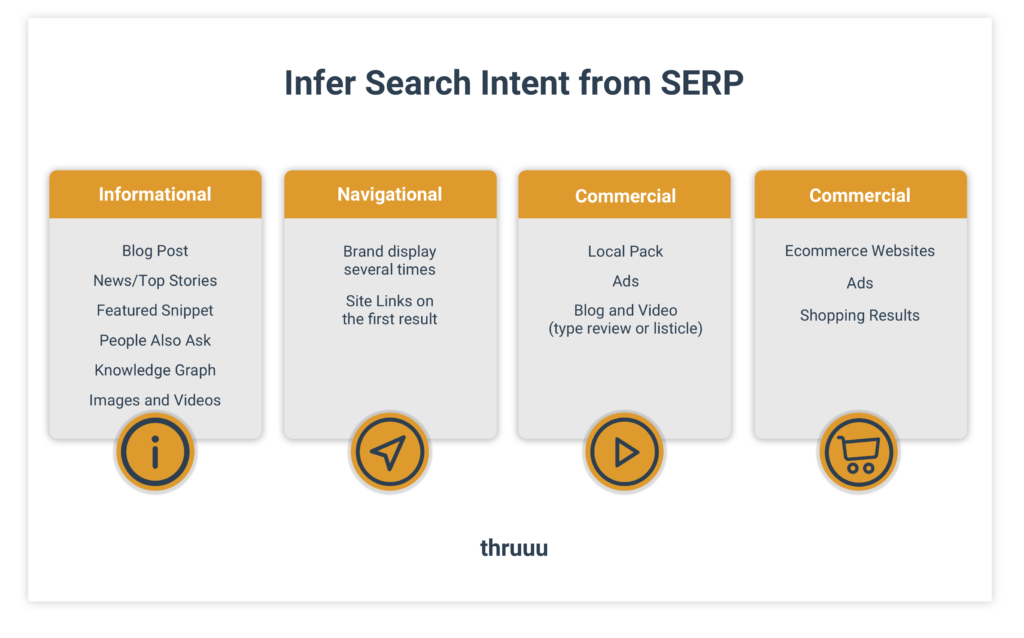
Understanding the type of search intent behind a particular query is important, as this will dictate the kind of content that performs best in Google.
If someone is looking for information (an informational query), provide comprehensive, in-depth coverage of the topic.
This could be in the form of a blog post, article, or even an eBook.
If someone is looking for a specific website or page (a navigational query), then ranking well on branded terms is critical.
If someone is looking to buy something (a transactional query), create content that is persuasive and convinces the reader to make a purchase.
This could be in the form of effective product descriptions, testimonials, or reviews.
And if someone has commercial intent but is conducting more research (commercial investigative intent), provide them with content that helps them make progress in their customer journey.
For example, buyer’s guides, comparison articles, or ROI calculators fall into this category.
Tip 2 – Make It Easy-to-Read
Readability matters for SEO content.
If a user arrives at a landing page on your website and is confronted by a wall of text that is difficult to read, they are likely to immediately bounce back to the search results.
It’s essential that your content is easy to read if you want it to rank in the SERPs.
Remember, many people may be viewing it on a mobile device.
Your content should be readily skimmable, even on the relatively small screens of mobile devices.
Break up your copy with:
- Headings
- Subheadings
- Paragraph breaks
- Bullet points
- Bold text
- Callouts
In addition, write in the active voice as much as possible, since it’s easier to understand than content written in the passive voice.
Also, depending on your audience, use easy-to-understand words, avoid overusing three-syllable and longer words, and a write at a reasonable readability level that your audience can easily digest.
Tip 3 – Cover the Topic in Full
Focus on covering entire topics instead of just keywords.
Thoroughly covering a topic significantly increases your chances of ranking both for primary and long-tail keywords.
Creating topic clusters is an effective way to ensure you thoroughly cover a topic.
A topic cluster is a hub-and-spoke model of content creation. It includes a primary pillar page (the hub) and related cluster pages (the spokes).
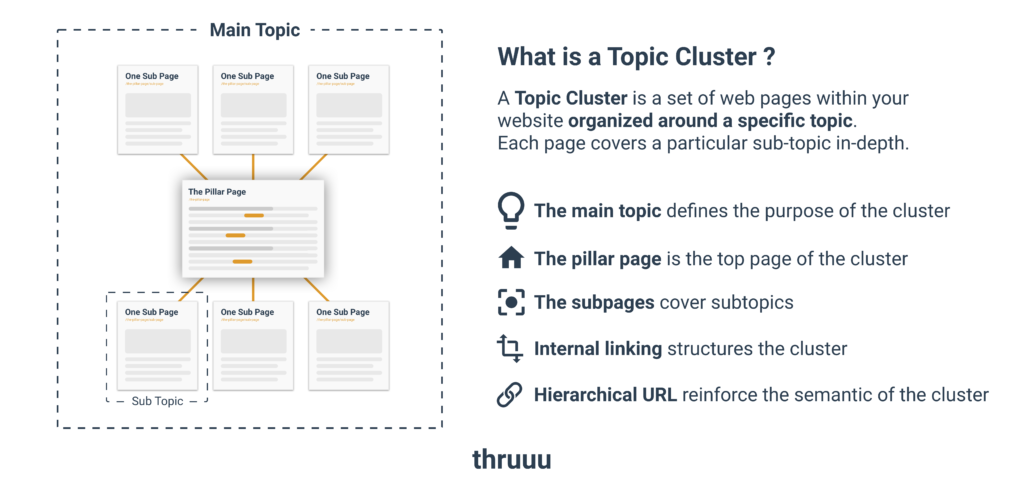
The pillar page covers a topic from top-to-bottom and includes many subtopics.
A cluster page covers a single subtopic in much greater detail. The pillar page links to each cluster page, and each cluster page in turn links back to the pillar page.
Organizing your content in such a way makes it easier for Google to understand the topic areas on which you are authoritative.
It also ensures that you cover a topic more broadly and thoroughly.
Additionally, it helps improve search rankings by passing link authority back and forth between the pillar and cluster pages.
Tip 4 – Add New, Unique Value
A common mistake in content marketing and SEO is producing content that simply regurgitates what’s already out there.
If you want your content to rank higher in Google, offer something new and unique.
Analyze the Google SERP and see what is already being offered and ranking on Google page one.
Understand the depth and breadth of the existing content. Explore the outline of the content there.
Identify any gaps that you can fill.
One way to make sure your content adds new value is to focus on a specific angle or perspective that is not being covered in-depth by the content on page one.
Speaking to first-hand experience or offering a unique story or case study, for example, helps to differentiate your content.
Another way to ensure your content is unique is to use propretary data or unique research.
For example, survey-based research or crowdsourcing. Not only does this make your content unique, it also tends to attract a significant number of backlinks.
Yet another way to add unique value is to engage readers more deeply. This might be through surveys or interactive tools.
With the thruuu Content Analysis tool, you can explore new ideas that are not yet discussed by your competitors. These are great insights to include something unique in your content.
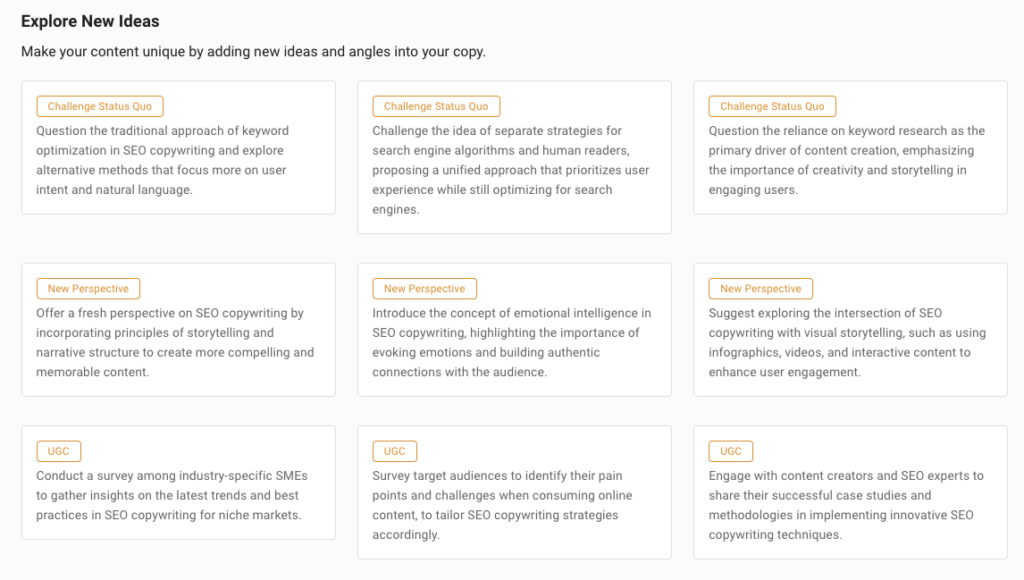
Tip 5 – Satisfy Google E-E-A-T Requirements
As mentioned earlier, Google prioritizes content that demonstrates E-A-T.
In order to do that, consider how you’ll showcase the expertise and authority of your writers and editors.
This may include a byline below the article, or it may be the use of separate author pages.
When describing writers and editors, point to their industry credentials and prior publishing experience. Highlight any leadership roles they have.
Other ways to enhance Google E-A-T is through the display of awards, association logos, analyst grades, customer testimonials, etc.
Tip 6 – Optimize the Title Tag and Meta Description
Your title tag and meta description are important aspects of SEO copywriting.
The title tag is what appears in the search results as the clickable headline, and the meta description is the brief snippet of text that appears below it.
Both the title tag and meta description should be optimized to include your target keyword.
The title tag is a direct Google ranking factor. Include the keyword as far to the left in the title tag as is naturally possible.
Although the meta description is not a direct ranking factor, the meta description plays an important role in attracting clicks.
Think of the combination of title tag and meta description as your “ad”.
A higher click-through rate (CTR) will typically be rewarded by Google with a higher ranking in the SERP, so strive to write them in a way that is likely to generate clicks.
If a particular page has a high number of impressions and a low number of clicks, it indicates that the title and the meta description aren’t particularly compelling.
If you need help writing a compelling title, use the thruuu Content Brief Generator. It can you help you and generate titles.
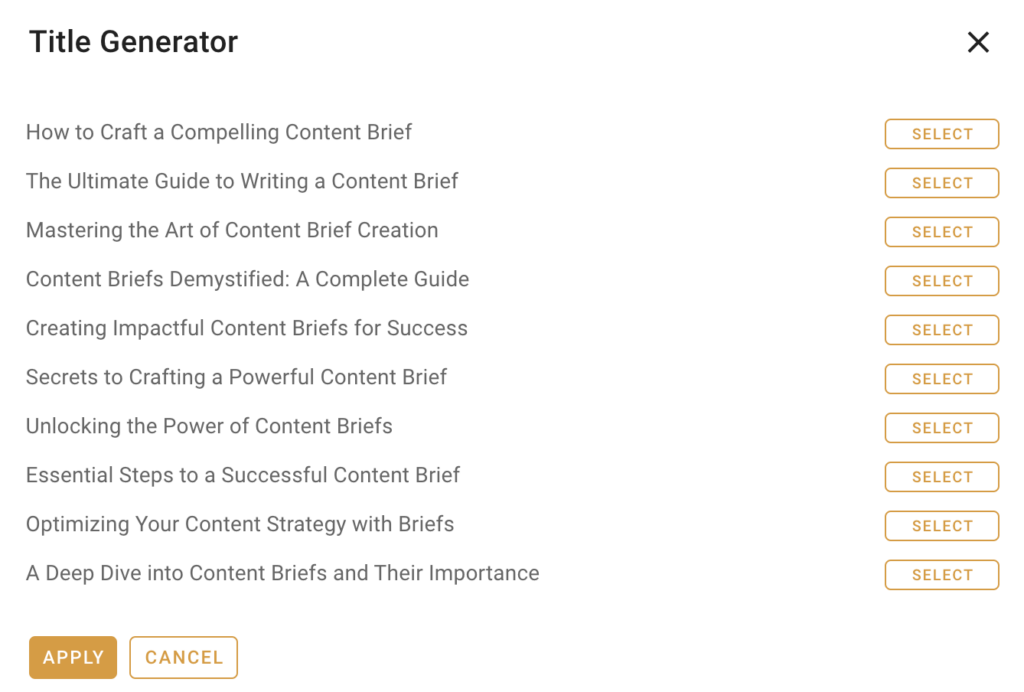
Tip 7 – Add a Table of Contents
If a piece of content is particularly long or has many different subsections, adding a table of contents can make it more user-friendly.
This allows users to quickly jump to any section of your content.
A table of contents also helps search engines get a better sense of the content and its organization.
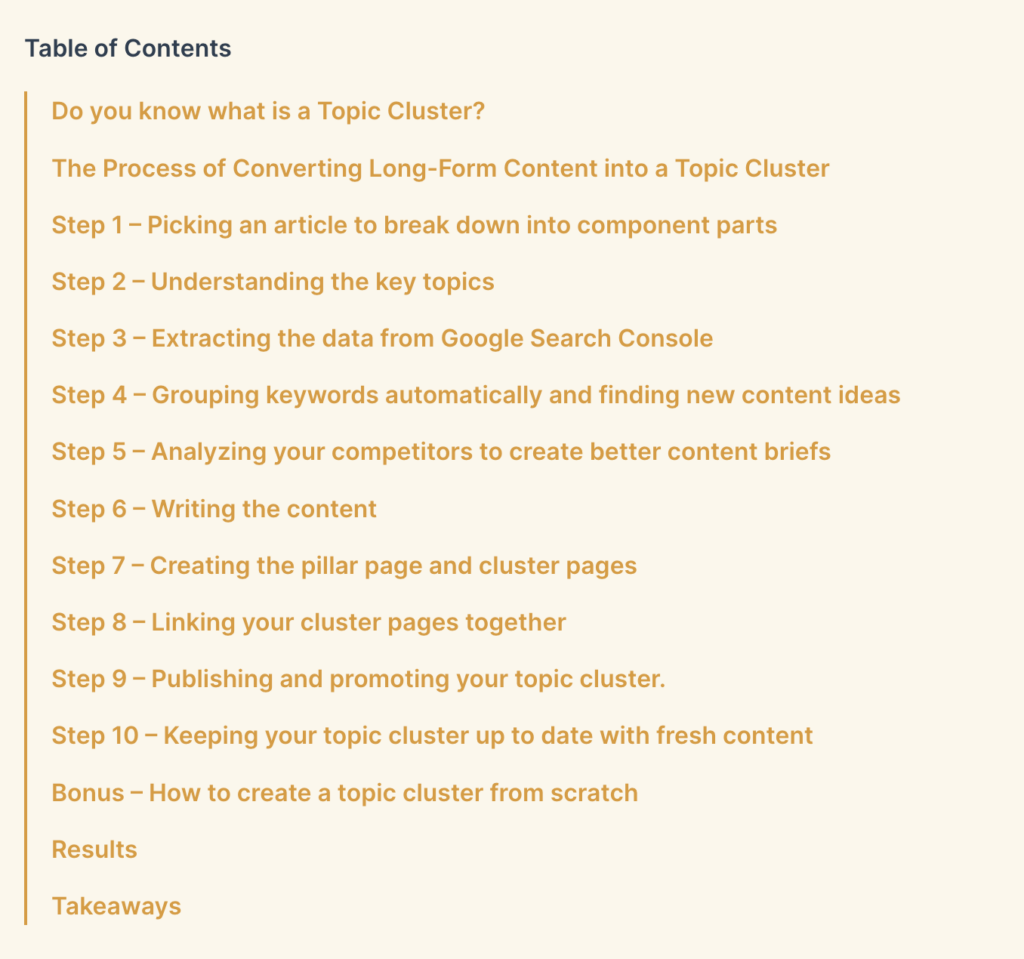
Tip 8 – Add the Primary Keyword to Your Introduction
With SEO copywriting, it’s important to include the target keyword in the introduction of a content piece.
This ensures that both users and search engines clearly know what the piece of content is about right from the start.
If users visit the page and don’t see their primary search term quickly, there’s a chance that they will bounce back to the search results.
If possible, try to include your primary keyword within the first 100 words.
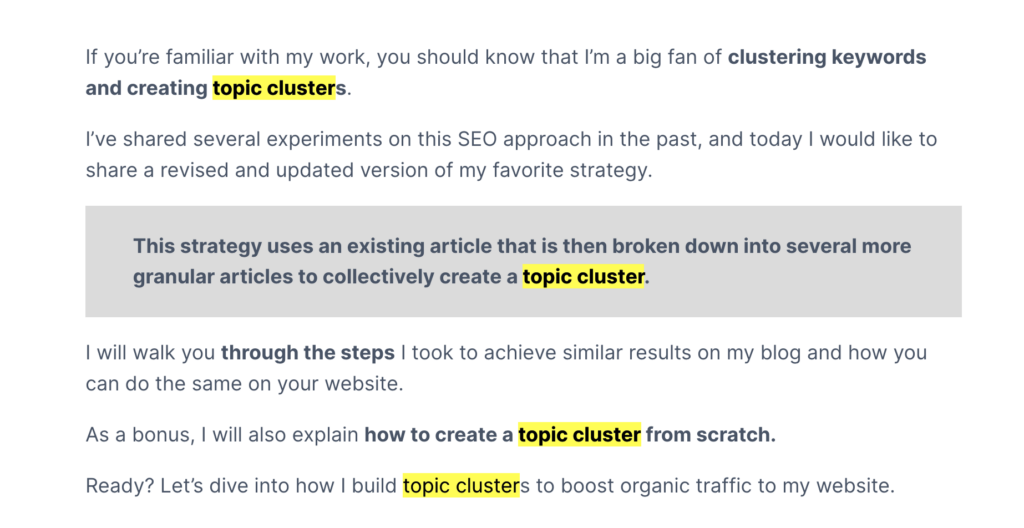
Tip 9 – Sprinkle Your Primary Keyword in the Copy Naturally
In addition to including your primary keyword in the introduction, you should also sprinkle it naturally throughout the page.
Tools like Clearscop can help you determine how many times you should use the primary keyword in your content.
Clearscope, for example, will give you a recommended usage range based on the actual number of times the keyword appears in the content on Google page one.
The tool also indicates the importance level for including the keyword in your headings.
When adding the primary keyword to your content, though, it’s important not to overdo it.
In addition to being bad for users, keyword stuffing could also trigger a penalty from Google.
Use your primary keyword naturally, in ways that are highly intuitive, but avoid keyword stuffing at all costs.
Tip 10 – Don’t Forget Related Keywords
To ensure that you thoroughly cover a topic, include related keywords in your content.
Including a variety of related keywords helps to show search engines that your content is comprehensive, and it also makes your content more likely to appeal to a wider range of readers.
Additionally, including related keywords makes it possible to rank in Google for more keywords, which translates into more organic search traffic.
All of this helps you to achieve greater ROI from a single content piece.
SEO tools like thruuu, Clearscope, and Semrush can help you find related keywords.
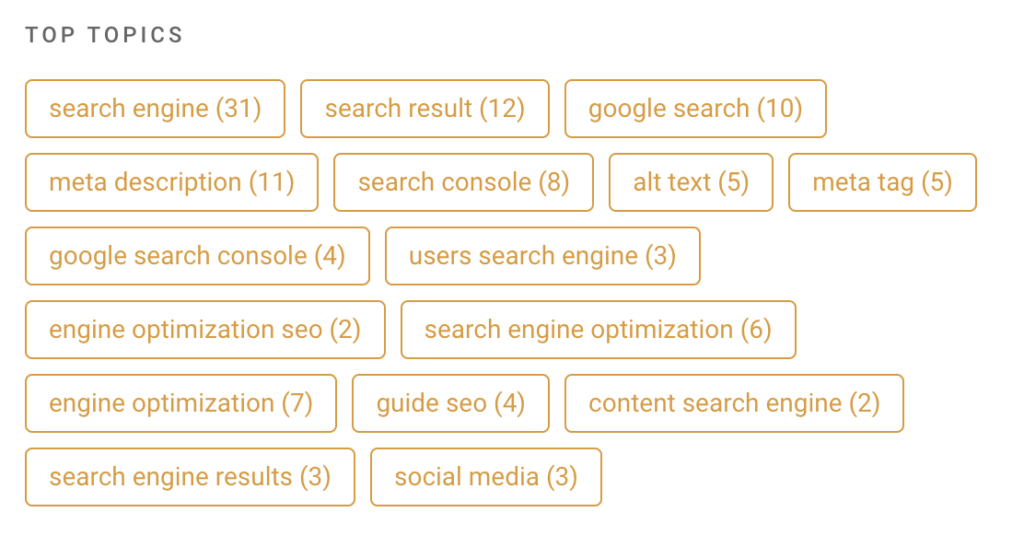
Tip 11 – Cover Common Questions Being Asked Online
SEO copywriting should focus not only on topics and keywords, but also on the most commonly asked questions online.
Answering common questions in your content helps you to capture highly qualified traffic, even search volumes may not be as high.
Additionally, addressing common questions in your content helps to show search engines that your content is relevant and useful.
This can lead to a higher click-through rate, which is a positive signal for SEO.
Answering questions also makes it more likely that you will capture the featured snippet in search results, since these are often answers to questions.
And finally, it makes your content more relevant to voice searches, which are often in the form of questions.
You can find common questions being asked online for a given keyword using tools such as thruuu, AlsoAsked, and Answer Socrates.
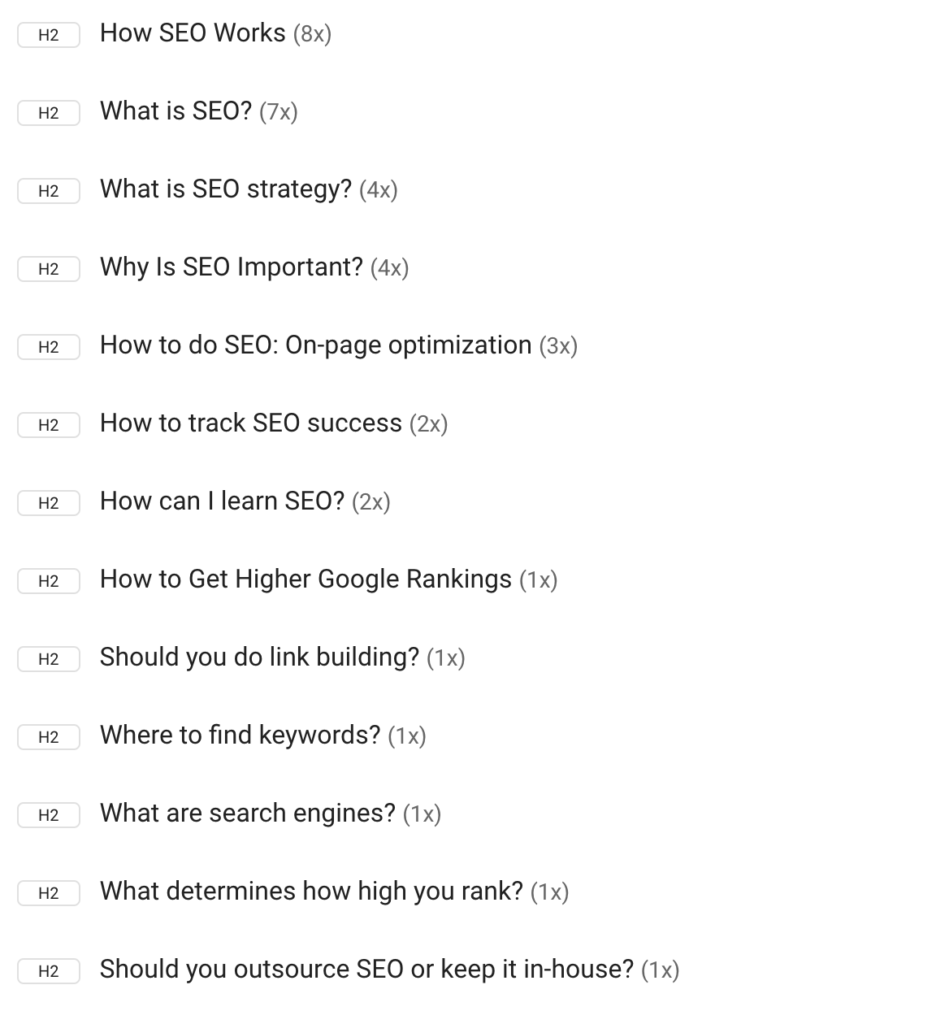
Tip 12 – Keep Content Sections Short
Within each content piece, keep sections short and to the point.
Say what you need to say without adding unnecessary words. Keeping sections short makes it easier for people to skim your content and get an overall picture of what you cover.
While there’s no hard and fast rule, Yoast recommends keeping each section of your content within 300 words.
Tip 13 – Keep Paragraphs Short
It’s also helpful for readers if you keep your paragraphs short. Large walls of text are intimidating and difficult to read.
They make it more likely that users will quickly abandon a page.
Make your content “snackable”. Ensure it’s easy to skim and digest. Use plenty of whitespace in your content so that it’s easy to read.
Tip 14 – Implement Internal Linking
Internal linking is an absolute necessity for SEO copywriting. There are several reasons for this.
First, it helps Google understand how different pages are related to each other.
If one page is linked to another, Google assumes that they are related in some way. If you want to establish topical authority, internal linking is a must.
Second, internal linking provides a better user experience. Users are able to quickly find related pages without having to search your website.
Finally, internal linking significantly impacts SEO results.
The anchor text of internal links signals the focal point of a page to Google.
In addition, internal links pass link authority between the pages. High-authority pages pass “link equity” to pages with a lower authority.
This, in turn, raises the authority of those pages, making it more likely that they will rank for target keywords.
Here is a simple trick to easily find spots for internal linking on your website.
Do a Google search following this pattern: site:your-website.com “your target keyword”
You will receive a list of your website’s pages mentioning the target keyword. You can edit each one and add a link to your new page.
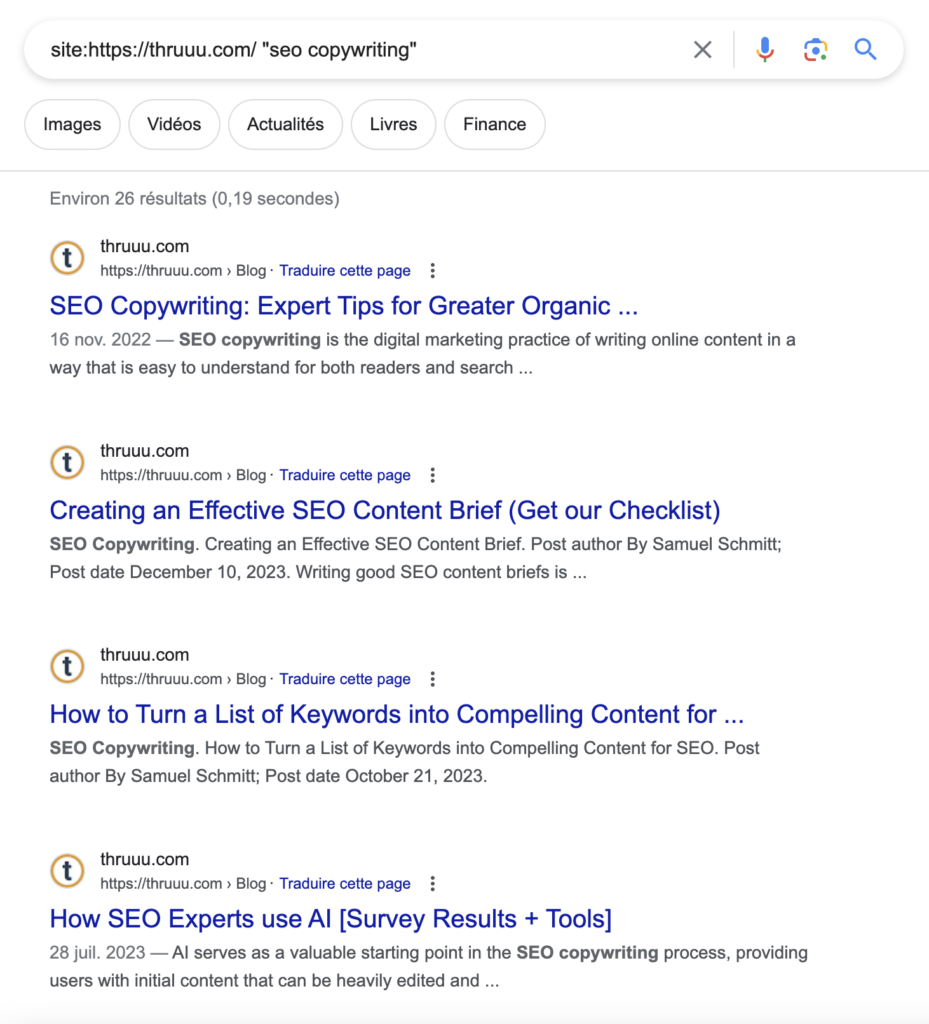
Tip 15 – Write to Attract Links Organically
Link building is an important part of any SEO strategy.
Google views backlinks as votes of confidence from other websites. All things being equal, more backlinks will translate into a higher Domain Authority and better search rankings.
In light of this, write content that will organically attract links. In other words, create content that’s so good that people can’t help but link to it.
This is called “passive link building”, and it’s often far more effective at generating high-quality links than overt link building campaigns where a brand asks for links from other businesses.
Consider the following when writing your content:
- Write for humans first. The best quality content is written for people first, not search engines. Keep your audience in mind when you write and make every effort to give them the best content possible. Surprise them! Thrill them!
- Write comprehensive, in-depth content. The more comprehensive your content is, the more likely people are to link to it. Strive to create “linkable” resources that will be referenced by many other sites.
- Keep your content updated. Outdated content is less likely to get links than fresh, up-to-date content. Additionally, the Google algorithm tends to favor newer content in many instances.
- Conduct original research. As we noted earlier, original research tends to attract a high number of organic backlinks. If you present new, data-backed insights into a subject, many websites will cite your research in articles, blog posts, and other content.
- Give away free resources. Giving away free resources like templates is an effective way to attract organic backlinks. Everyone loves something that’s free.
- Create linkable infographics. Visually engaging infographics are often shared on other websites. Include a small snippet of HTML that makes it simple for sites to link back to yours when they post the image.
Tip 16 – Consider Adding a FAQ
A significant percentage of searches in Google are written as questions as opposed to merely keywords.
If you want to capture the featured snippet and attract clicks from these types of searches, consider adding a FAQ section to your content that answers such questions.
A well-optimized FAQ in your content can help you rank in Google’s featured snippet.
As noted earlier, the featured snippet often appears as an answer to a question. Including an FAQ section as part of your SEO copywriting strategy is a simple way to improve rankings for specific keywords.
Tip 17 – Include CTAs
In order to generate greater ROI from your SEO copywriting, make sure you include contextually-relevent CTAs in your content pieces.
Too many companies limit the use of CTAs to merely one per content piece, but using multiple CTAs in a single content piece will help you to appeal to different readers.
Mix it up with different CTAs on the page to help you appeal to readers at different stages of the customer journey.
Experiment with behaviorally-triggered CTAs. The bottom line is that CTAs help you strengthen your bottom line.
Empower Your Content Team
Our end-to-end content optimization solution empowers your team to crack the Google algorithm, craft exceptional content, and achieve remarkable organic search results.
SEO Copywriting Tools to Help You Get Started
You won’t need to invest a lot in SEO tools if you want to start creating content.
As we mentioned in the article about the best SEO Tools a B2B SaaS, our current SEO tool stack cost less than 99$ month and is made of very few tools.
For keyword research, we use Keyword Everywhere and Google Search Console.
The Google Search Console is clearly the best keyword tool, and you can use it for free.
Then for the competitor analysis and content brief, we use our own solution, thruuu.
You can check my Content Workflow and see how I use these copywriting tools.
If you want to explore more SEO Copywriting tools, I invite you to read the following article.
Why Copywriting is Important for SEO
Copywriting is important for SEO for a number of reasons, as outlined below.
Helpful Content
First, it significantly improves the user experience.
Content that is well-written and relevant to the reader’s needs will keep them on the page longer.
This signals to search engines that the page is providing value, which helps to improve its ranking. On the other hand, poorly written and unorganized content will cause site abandonment.
Google explicitly writes that content should always be created for humans, not just search engines. Talking about their recent “Helpful Content” update, Google states:
“The helpful content update aims to better reward content where visitors feel they’ve had a satisfying experience, while content that doesn’t meet a visitor’s expectations won’t perform as well…SEO is a helpful activity when it’s applied to people-first content. However, content created primarily for search engine traffic is strongly correlated with content that searchers find unsatisfying.”
Copywriting and Keyword Targeting
Second, copywriting can influence keyword targeting.
By including an appropriate keyword in the title, headings, and naturally throughout the body of the text, you can ensure that your content maps to the right Google queries.
This will result in more organic traffic to your site.
Furthermore, by including relevant related and long-tail keywords, you expand your content’s visibility across a broader range of Google searches.
Backlinks
Third, SEO copywriting can help to build links.
By creating high-quality content aligned to search intent, other websites are more likely to link to it.
This helps to improve your site’s authority and ranking.
Conversion Rates
Fourth, SEO copywriting improves conversion rates.
Writing content that is persuasive and relevant encourages site visitors to take the desired action, whether it’s subscribing to a newsletter, downloading a white paper, scheduling a demo, or making a purchase, etc.
Trust-building
Finally, good copywriting helps to build trust.
Users are more likely to trust a site that has well-written, informative, relevant, and comprehensive content.
Additionally, well-written content with high-quality backlinks pointing to it demonstrates expertise and authority.
Google prioritizes content that demonstrates Expertise, Authority, and Trustworthiness (E-A-T).
How to Approach SEO Copywriting in the Generative AI Era
Producing content at scale doesn’t have to be costly, especially with the plethora of Generative AI tools available.
It may be tempting to input a list of keywords, wait a few minutes for SEO content generated by AI, and then publish it on your website.
However, should you do this?
While generating content with AI is effortless, the real concern lies in producing low-quality content for the sake of driving traffic.
As we’ve discussed previously, crucial components of SEO Copywriting are understanding your audience and providing them with fresh insights to distinguish your brand.
My advice is to still conduct a thorough analysis of your audience and the content they seek, utilizing AI support if necessary, but never neglect the human touch and expertise.
It’s worth noting that in March 2023, Google penalized many websites and deindexed them from search results due to their production of low-quality content.
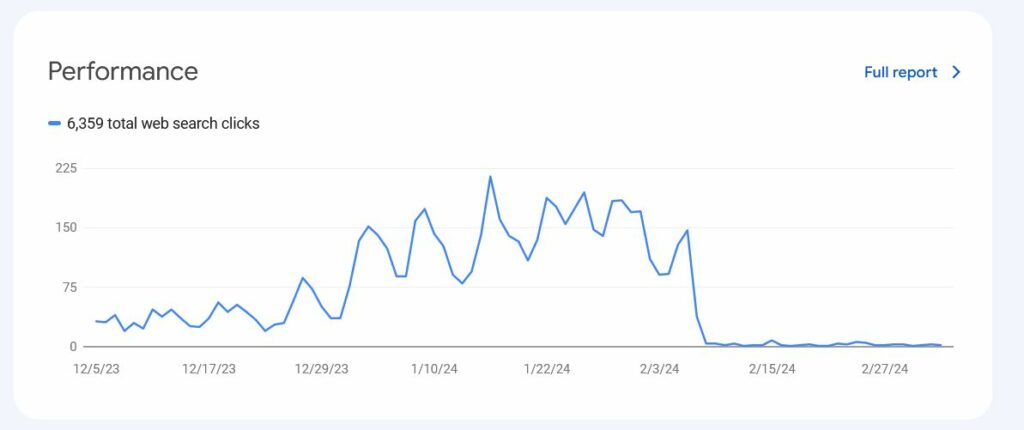
In conclusion, focus on creating superior SEO content, adhere to SEO copywriting best practices, and safeguard your website against potential harm from future Google updates.
Make Better SEO Content
Capture hundreds of on-page data points of top ranking content instantly using thruuu, and improve your SEO copywriting and organic search results.
